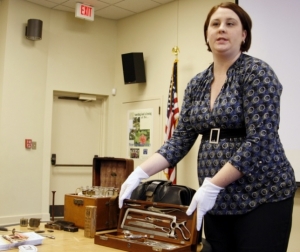Old Dobbs Society gets lesson in rural medicine
By Catharin Shepard
Published in News on January 18, 2009 2:00 AM

News-Argus/GREG SOUSA
Jennie Schindler, historic site manager of the Country Doctor Museum in Bailey, demonstrates some of the items a country doctor would have used to practice medicine in rural North Carolina in the early 19th century during a presentation to the Old Dobbs Society Genealogical Society at the Wayne County Public Library on Saturday.
The modern health care industry is one of the most tightly regulated in the United States.
Most doctors have access to the latest diagnostic equipment, the Food and Drug Administration closely monitors the development of new drugs, and prospective physicians face years of rigorous education before they ever see their first patient.
But in the days before the Internet, television and even before the advent of gasoline-powered vehicles, when the sick or injured needed care, they often turned to their local country doctors.
Jennie Schindler Graham, historic site manager of the Country Doctor Museum in Bailey, spoke Saturday to the Old Dobbs County Genealogical Society at the Wayne County Memorial Library in Goldsboro about the history of medicine in rural North Carolina.
"There weren't any diagnostics at that time," said Mrs. Graham. "If you had a fever, what would they do? They would try to reduce the fever."
A cold compress might work for a fever, but for managing pain, early doctors had a plethora of questionable drugs to ease suffering, and many such "patent medicines" were nothing more than dangerous concoctions of alcohol, opiates, morphine and even heroin.
"Mrs. Winslow's Soothing Syrup, which was meant for babies that were teething, contained heroin," said Mrs. Graham.
Most history books don't reveal that after the Civil War, many veterans developed drug addictions to the same medications that had helped to save their lives on the battlefield.
"A lot of Civil War veterans were addicted to opiates," she said.
The Country Doctor Museum stores and displays hundreds of pieces of old medical equipment, including a 19th century doctor's case, the precursor to the iconic doctor's bag.
"Later, this really becomes the symbol of the country doctor," said Mrs. Graham. "It could withstand traveling, making house calls."
Most doctors rode horses or traveled in horse-drawn buggies and had to use padded boxes to keep delicate instruments and fragile glass containers safe over rough terrain.
Several of the glass bottles tucked inside the sturdy leather-covered box were unmarked, but a few were labeled and still legible.
"Sixty-two percent alcohol. Ether, chloroform," said Mrs. Graham, reading the label of one vial. "It's various cocktails of painkillers."
The museum also displays a horse-drawn buggy and two different Ford Model T automobiles, examples of how traveling doctors would rush to their patients' bedsides.
The country doctor was a staple of almost everyone's life until about the 1900s, but in many rural areas country doctors continued making house calls until the 1960s.
And in a way, it was the development of faster transportation that marked the end of the country doctor.
"People could get out on their own more readily," said Mrs. Graham.
The Country Doctor Museum is managed by the Laupus Library of East Carolina University, which took over maintenance of the collection in 2003. Founded in 1967, the museum is one of the oldest of its kind and offers guided tours Tuesday through Saturday. Call (252) 235-4165 for more information.
The Old Dobbs County Genealogical Society seeks to preserve the history of Old Dobbs County -- the tract of land that was later divided to form Wayne, Lenoir, Greene, Wilson and Jones counties.
The Society also strives to facilitate the exchange of genealogical information and preserve the information of the families of Old Dobbs County.
The group holds meetings the third Saturday in January, April, July and October in the Weil Auditorium of the Wayne County Public Library. For more information, visit www.rootsweb.ancestry.com/~ncodcgs.
